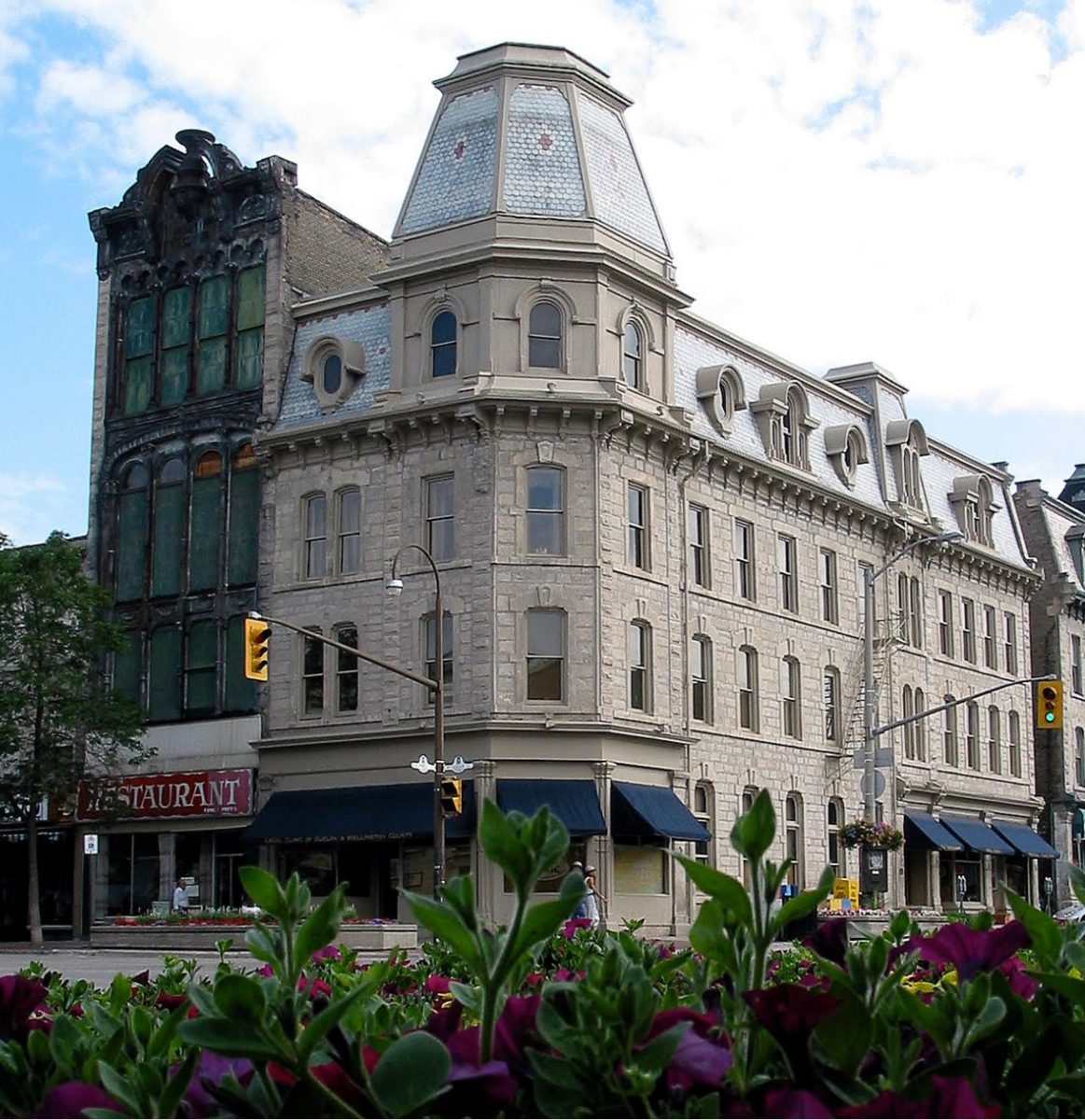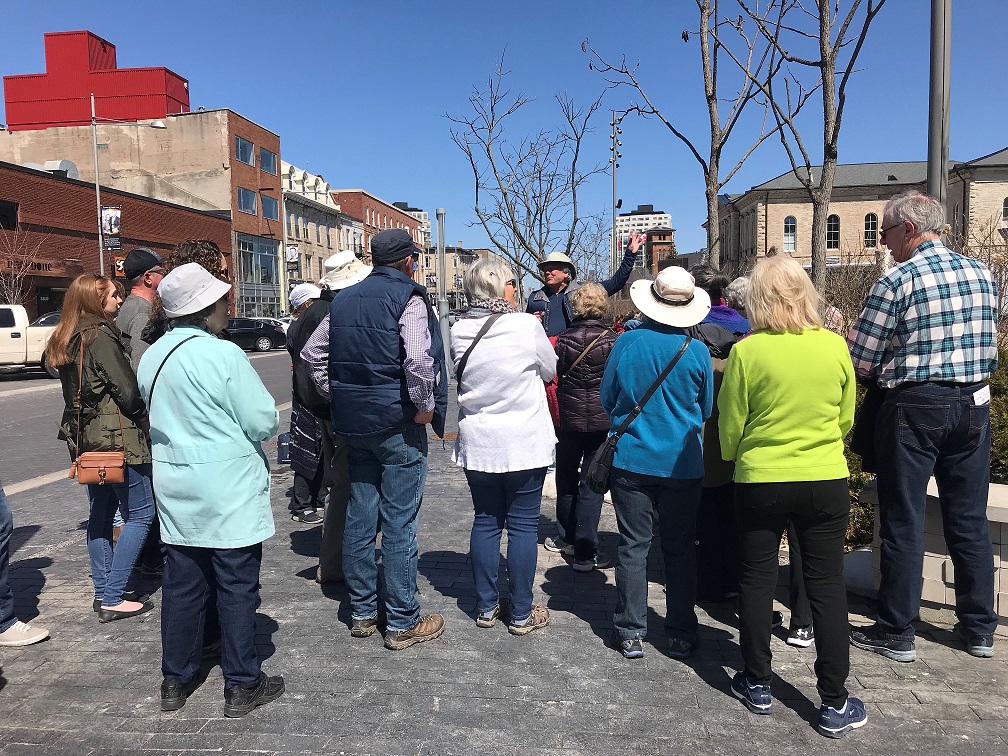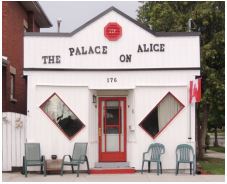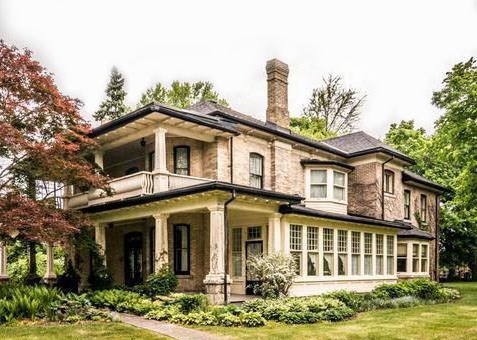Have you ever wondered about the stories that live in buildings you pass every day? Or wondered how a Guelph street or square got its name? Why are Guelph streets arranged the way they are? Why are there no tall buildings downtown? Our Historical Walking Tours are a fun and affordable way to learn those stories while taking a walk around Guelph neighbourhoods.

Whether you live in Guelph or you’re a visitor, you can learn about Guelph’s history while taking in the architectural and natural features of the city through six different tours. GAC has promoted the cultural heritage of Guelph through these tours for more than 30 years.
A group of dedicated volunteers takes turns leading the tours, each adding their own personal touch to the history. Fran Tymchyshen has been a guide since 2018. “I tend to really get into the information to understand connections and little tidbits of local history to add to the tour,” Fran says.
Fran says that in addition to architectural highlights, tour guides give you more personal stories. “We know all the connections, like the person who bought this house also bought that house. We get to know the names of the powerful families of the past. It’s almost like a soap opera, some of the things that happened, such as how a toll-free bridge came to be. Or the family that made cannon balls and shipped them to the U.S. South and said their shipment was potatoes.”
Fran developed a love of limestone buildings when she lived in Kingston and is drawn to Guelph’s stone. “It’s a beautiful feeling being with the limestone houses.” She likes how walking tours help people notice what is around us. Fran says you can pass a building 100 times and not notice a little sculpture on the side of it, or a detail like the flowers on the building that houses Miijidaa Café & Bistro on Quebec Street.
The walking tours have changed over the years, including shortening the time from over two hours to 60-90 minutes, so participants and guides don’t get worn out. The start time also changed from afternoons to 10 a.m. Fran says mornings are nice because they’re cooler in summer, and participants often bring a guest and go out for lunch after. Although the tours used to pause in July, this year they will run right through the summer.

Note that these tours cover history only from the time and perspective of European settlement of what is now called Guelph. Guelph is located on the ancestral lands of the First Peoples and the treaty lands of the Mississaugas of the Credit.
To join a tour, please register ahead by clicking on the date you want and then paying $8 online. Spaces are limited to 10 people this year so register early! Tours with fewer than two registrations by the previous Friday at 4 p.m. will be cancelled. Although the tours take a leisurely pace, participants should wear comfortable walking shoes. Masking is optional but attendees are encouraged to physically distance. Custom dates can also be arranged for things like family gatherings or work groups.
You can also pick up printed Historical Walking Tour booklets for $5 each at GAC (42 Carden St., Unit 1B, currently by appointment). These booklets offer drawings and information for self-guided tours and make great gifts or keepsakes of a tour. You can also open/download updated digital walking tour booklets at the bottom of GAC’s walking tours webpage.
Here are the six tours:
Where Guelph Began
Encircles the original Market Square area laid out by John Galt in 1827. Serving as the focal point for Guelph’s early social and business life, the area also contains the sites of many of Guelph’s first buildings.
Downtown Walkabout
The present downtown centre of Guelph, with its wide main street, provides a compact walking tour, which includes many buildings and sites of considerable historical and architectural interest.
Slopes of the Speed
Explores the slopes of the Speed River between Norwich and Macdonell Streets, where many of Guelph’s largest and most distinguished historic homes are located.
Altar and Hearth
A glimpse of the Victorian era in Guelph, covering the area west of Norfolk Street, between Essex Street and London Road, the tour includes several historic stone churches and many historic homes representing a variety of architectural styles.
Brooklyn and the College Hill

Explore one of Guelph’s early industrial sections, formerly known as Brooklyn, as well as the College Hill area that developed around the Ontario Agricultural College. Includes some of the city’s best examples of masonry and stone carving.
Ward One
The area southeast of the downtown, between the Speed and Eramosa Rivers, reveals the rich variety of historic architecture and the diversity of peoples who formed Guelph. Particular attention is devoted to residential/industrial proximity and the city’s early Italian community.
You can register now for all tours from May 1 through September.
GAC is grateful for the support of Sleeman Breweries and the Downtown Guelph Business Association for this program, as well as our wonderful volunteer tour guides.
This Content is made possible by our Sponsor; it is not written by and does not necessarily reflect the views of the editorial staff.

